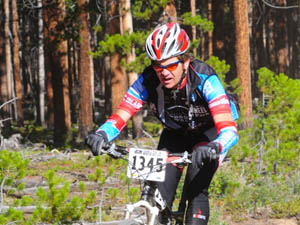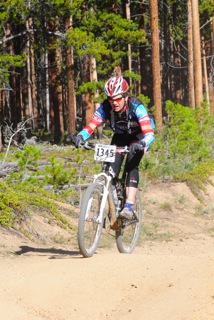
A New York City Roadie’s Adventures at the Leadville 100
On Saturday at 5.15 AM I dropped my mountain bike at the starting line for the Leadville 100, the hundred mile high-altitude mountain bike race which starts in the old Colorado mining town of Leadville, elevation 10,200 feet, and reaches a high point of 12,550 feet with 14,000 feet of total climbing. The race doesn’t start until 6.30, but you need to park your bike early as there were 1400+ starters. Even though I was an hour and fifteen minutes early, I was a good 500 places from Levi Leipheimer and the other pros in the first row. The goal of the Leadville 100 is to finish in under the 12 hour cut-off, earning a coveted silver belt buckle. Along the way there are time cut-offs where riders are pulled. Usually only three-quarters of the riders make it to the finish. It was 38 degrees out and I had plenty of time to drink some coffee and wonder “what the hell am I doing?” I’m a forty-five year-old Brooklyn roadie who has done exactly zero mountain bike races. I’ve done a half-dozen years of cyclocross, and have spent a fair amount of time off-road in Portland, Oregon, where Tin House, my literary magazine, has an office. Still, I had only owned a mountain bike for six months, and it had been stolen the month before. I had used the insurance money to upgrade to a Santa Cruz carbon with Easton wheels. I had a good ride going in, if not thoroughly tested.
 After a shotgun blast signaled the start, we dropped downhill out of Leadville for three and a half miles in a neutral 20mph roll to where the course switched to dirt, and where those not totally frozen tried to move up before the first hard, rocky climb up St. Kevins. Imagine the most crowded cyclocross start, add 1,300 more people and extend it an hour and half, and that is what the first fifteen miles felt like. Up St. Kevins it was slow and steady as riders spun out and had to push until finding an unsteep place to remount. I picked my way around the pushers, made it to the fist of the six aid stations where I downed some extra water and Coke (for some reason, at high altitude, Coke is one of the best possible drinks as it provides calories, caffeine, and fights off altitude sickness). After a steep plunge, it was another long, less-steep climb up to the notorious Powerline descent. Powerline is an old jeep road that has become deeply rutted over the years so that there is now a trench running down the middle and for three miles you need to swoop back and forth across the trench at high speed.
After a shotgun blast signaled the start, we dropped downhill out of Leadville for three and a half miles in a neutral 20mph roll to where the course switched to dirt, and where those not totally frozen tried to move up before the first hard, rocky climb up St. Kevins. Imagine the most crowded cyclocross start, add 1,300 more people and extend it an hour and half, and that is what the first fifteen miles felt like. Up St. Kevins it was slow and steady as riders spun out and had to push until finding an unsteep place to remount. I picked my way around the pushers, made it to the fist of the six aid stations where I downed some extra water and Coke (for some reason, at high altitude, Coke is one of the best possible drinks as it provides calories, caffeine, and fights off altitude sickness). After a steep plunge, it was another long, less-steep climb up to the notorious Powerline descent. Powerline is an old jeep road that has become deeply rutted over the years so that there is now a trench running down the middle and for three miles you need to swoop back and forth across the trench at high speed.
When I pre-rode the section it was fast and scary. Now, with riders all around, it was terrifying. Especially after a spectacular crash in front of me, where a rider face-planted and another went over him, breaking his collarbone (the first of three broken collarbones that I witnessed). As I slid by, a couple of doctor/riders were ripping open the crashed rider’s shirt. Any thoughts of bombing past slower riders quickly faded. After making it through Powerline the crowds thinned out on the long up and down stretch across the high, windy plateau leading to Twin Lakes and the 3,000 foot grind up to the Columbine Mine turnaround. At Twin Lakes I dumped my arm and knee warmers as the sun was now fully out at 10am, forty miles and three and half hours into the race. Last year it had been sleeting, and many riders had had to abandon because of hypothermia. Half of the Columbine climb is up a graded jeep road, and near the end of this section Levi Leipheimer streaked past on his way back. Everyone now had to move to the right as the pros were flying by in five-minute gaps. One went off the road, off a ridge and into a grove of Aspens. At the end of the graded section, the course veers straight up onto a steep, dusty trail covered with loose rocks. I rode by a lot of people trying to push their bikes, some literally falling over. A few times I spun out or got stuck behind someone who had fallen over and had to push. By now we were well over the tree line and had spectacular views of the Continental Divide.
Five and half hours into the race I hit the turnaround. The hardest climb was behind, but there were still several brutal climbs left, not to mention the half hour descent back to Twin Lakes. I hit my back brake so much that it overheated and the disc stopped working for stretches where I had to pump it a few times before it would work again. Imagine riding a jackhammer for half-hour stretches. Two days later and I can still barely make a fist. I felt like a total wuss thinking about David Wiens, the six-time winner, who rides a hard tail. Back to Powerline it was all about eating and drinking, and staying out of the wind. Out on the plateau it is exposed and the crosswinds are brutal, so finding any kind of shelter was a bonus. Groups of riders clustered together and commiserated. Next was Powerline, which, after nearly 80 miles and nine hours in the saddle, felt brutally steep. All along the way riders spun out, some just sat down to catch their breath. Marshals cheered us on saying, “Wiens pushed it here, Tinker crashed here, Wiens went off course there.” We were in good company in our misery. Afterwards, Leipheimer said it was the hardest day he’s ever spent on a bike. Near the top of Powerline I crashed going 5mph, hitting a rock and falling over. Comical, but it slightly bent my rear derailer and I couldn’t get into my bottom two gears, meaning that I was now grinding the steep stretches.
At the top of Powerline I was nearly out of liquid. Not a good thing as the sun was beating down and after a long descent there was a three and half mile grind up to St. Kevins. Those were really, really long miles. I kept trying to get a few more drops out of my empty water bottles. I put my head down and tried not to notice a few riders who had stopped and were stretched out, suffering from cramps, dehydration, heat exhaustion, or sun stroke. After what seemed like forever I made it to the last aid station where I drank everything in sight, refilled my two bottles and settled for the St. Kevins descent. Rocky, steep, my hands numb, my vision a little blurry, and after nearly ten hours of riding, I was happy to make my way down to the bottom in one piece. After that it was flat ramble for a few miles into one last three-mile climb into town. I passed by a couple of riders who were looking at their Garmins, saying WTF? The Leadville 100 is actually 103.5 miles, the GPS mapping straightening many of the small curves. Finally, into town and a huge crowd, I made it in at 10.54.59. Without a doubt the hardest physical thing I have ever done. A few final numbers: I was 584th out of 1400+ starters. There were nearly 200 DNS’s (those who came to their senses in time). 908 riders made the 12 hour cutoff. Another 114 were allowed to finish under 13 hours, but did not receive belt buckles. 400+ riders were DNF’s

Thanks for sharing it.
You don’t say much about how that affected you – were you out in Colo at altitude for a while before the race? I once puked my guts out in a hotel in Leadville after doing a warm-up x-c ski day before heading higher up into some huts (that was probably 1-2 days from NYC). Should’ve stayed a few thousand feet lower that night. I can imagine finishing this thing with a crushing headache, but I know it affects different people differently.
I was definitely a little woozy at the top, but I’ve spent a lot of time in Colorado over the years, so my body was used to it. I got to Colorado on Tuesday, stayed in Aspen at 8,000 feet, rode parts of the course during the week. I was there six weeks before for five days, riding up over 12,000 feet which also helped.
Cool, thanks for adding that.
Can’t imagine racing in that thin air. I get crippling headaches as well as asthma like wheezing above 10K. Nice job Rob.
fantastic. ouch. wow.
While you cant account for personal variations on the effects of altitude, one adage rings true-sleep high, train low.
True. However, many flatlanders experience sleep disturbance and insomnia at high altitude until acclimatized.
Great inside look at the horrors and tribulations of the actual trail and some of the incidents that occurred on it.
My heart goes out to all those who got hurt or didn’t make it.
Amazing story, amazing experience, amazing endurance!
… felt like i was there
You should make the Iron Horse your next adventure!
http://www.climbingdreams.net/ctr/
Check it out, they filmed this race. Maybe you are in it.
http://www.racearossthesky.com
http://raceacrossthesky.com/